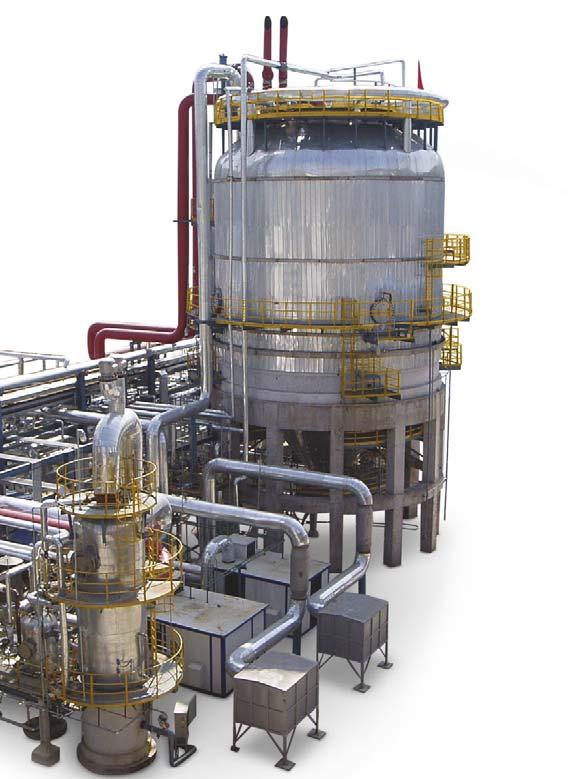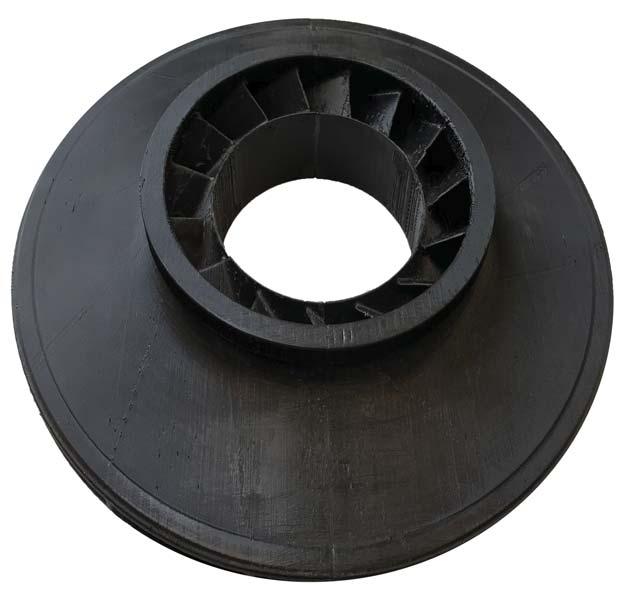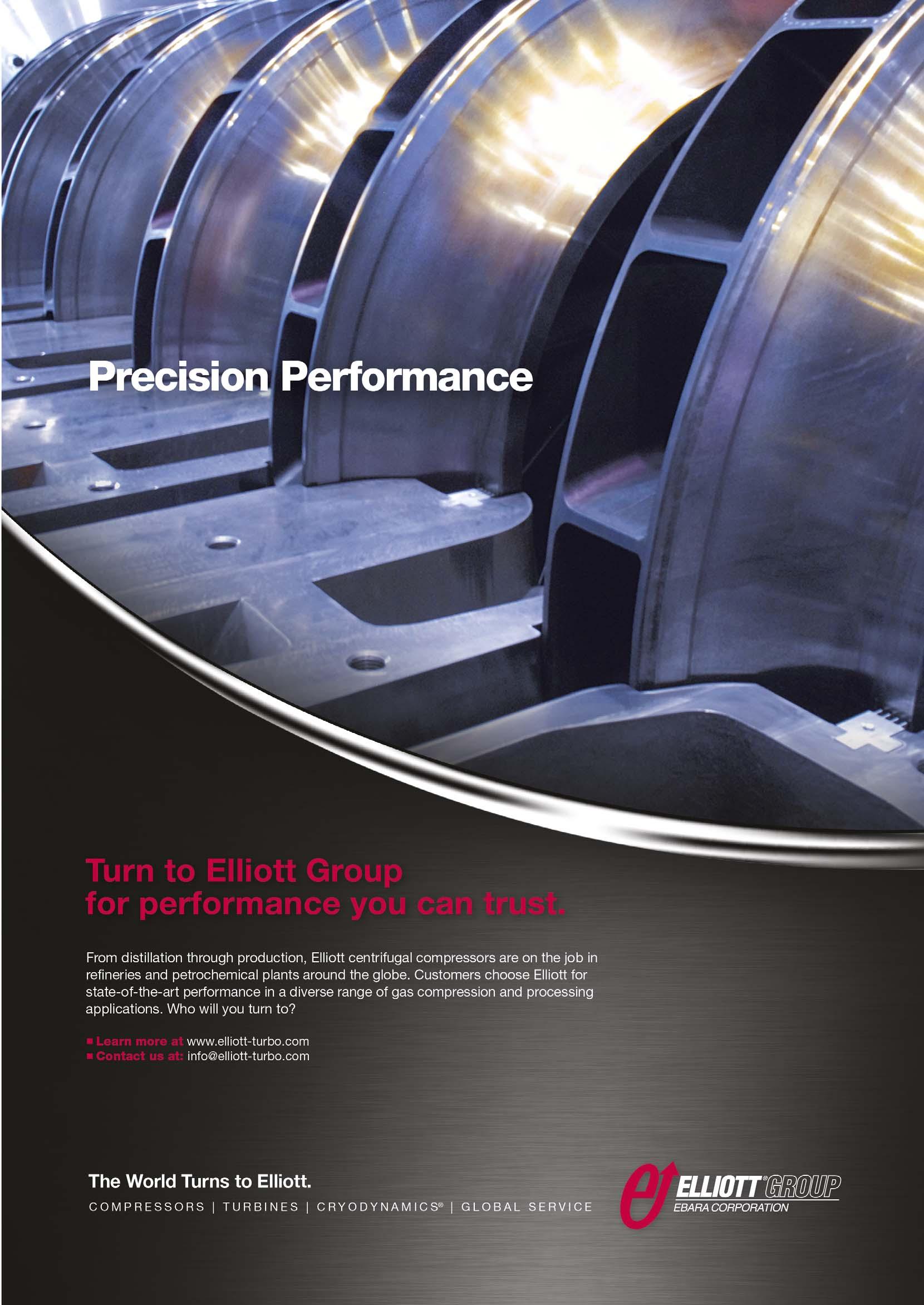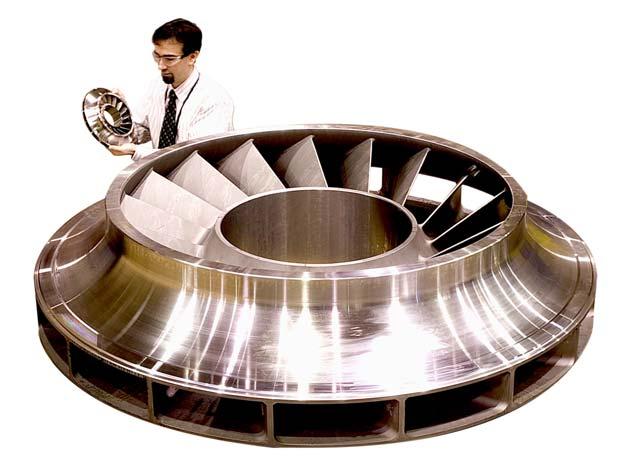
12 minute read
Moving toward a decarbonised world






Dr Klaus Brun, Elliott Group, explores the role of compressors in a decarbonised energy economy.

Hydrogen is abundant in nature and can be utilised as an energy carrier and storage medium in a decarbonised energy supply system. While hydrogen can be produced from water in a reasonably effi cient, simple but expensive electrolysis process, most hydrogen that is currently utilised is derived from conventional hydrocarbon sources, such as natural gas and coal, and thus is not inherently carbon free.
Nonetheless, the promise and potential of hydrogen to lead toward a decarbonised energy infrastructure has resulted in signifi cant investment in technologies to effi ciently produce, transport, store, and utilise hydrogen.

Hydrogen production processes

The three most common processes to produce hydrogen on an industrial scale are electrolysis, steam reforming, and gasifi cation partial oxidation. There are many variants of these processes, but their fundamental difference is that for steam reforming and partial oxidation, a hydrocarbon is required as a feed material, whereas electrolysis simply requires an electric power source and water. As such, electrolysis naturally lends itself to applications where energy storage is the primary objective of the hydrogen conversion. On the other hand, steam reforming for natural gas or partial oxidation for coal are complex chemical processes that convert a fossil fuel into hydrogen, carbon monoxide, and other compounds through an incomplete oxidation reaction which allows the hydrogen to be separated from the mixture. Clearly, this type of hydrogen is not necessarily environmentally friendly and requires carbon and other emissions controls to produce climate change neutral hydrogen (also known as blue hydrogen). Nonetheless, because of the low cost of fossil fuels and the relatively low cost of the plant process equipment, over 98% of all the hydrogen that is currently produced is derived from steam reforming and partial oxidation of fossil fuels.
In a decarbonised energy economy, the principal energy carriers will be electricity and hydrogen. Hydrogen has the advantage that it can be easily stored, while electricity has the advantage that it does not have to be re-converted to be





useful for most applications. For the foreseeable future, most hydrogen will be derived from hydrocarbons, probably natural gas. The basic reason for this is that electricity conversion to hydrogen from alternative energy sources is too expensive in terms of capital cost and roundtrip effi ciency (which is 50% at best). Several widely-debated studies have shown that, even if the supply cost of electricity is zero (i.e. for avoidance of wind curtailment), the total cost of producing hydrogen via electrolysis is still higher than producing it from natural gas because of the high initial and maintenance costs of electrolysers.
Steam reforming
Converting natural gas to hydrogen via the methane steam reforming process is a proven and relatively inexpensive process. Natural gas is abundant and cheap, especially in North America. Even if natural gas prices should rise, coal to hydrogen production via gasifi cation partial oxidation is also a commercially viable option that is less expensive than electrolysis. Thus, the hydrogen that will most likely be utilised in a decarbonised energy economy is blue hydrogen from widely available natural gas. However, for every ton of hydrogen produced from natural gas, approximately 8 – 12 t of carbon dioxide greenhouse gas will also be produced. Consequently, there are three important gas streams that will have to be dealt with in a decarbonised economy: Natural gas will have to be produced and transported to the site where it is converted to hydrogen. Hydrogen will have to be transported to its end-use site. Carbon dioxide will have to be transported to an appropriate geological sequestration end-storage site.
All of these gas streams require signifi cant compression. Although the natural gas to hydrogen conversion can be performed at the natural gas well site or a centralised gas plant, or near the end-use location, because of the existing natural gas infrastructure and the cost of developing a completely new hydrogen transport infrastructure, it is likely that in most cases the conversion will be performed near the site where the hydrogen will be utilised; i.e. near a power plant that utilises hydrogen fuel for combustion or near a fuel-for-transportation distribution hub. In a few cases, the central production location (gas plant) may be more economical if it happens to be located near a geologically viable carbon dioxide sequestration location such as a salt dome or an abandoned oilfi eld. In most cases, the existing natural gas pipeline and storage infrastructure worth billions of dollars will dominate the economics, and the natural gas to hydrogen conversion will be placed as close as possible to the end use location of the hydrogen to minimise the cost and complexity of having to transport the hydrogen.
The concept of blending hydrogen into natural gas using the existing pipeline network is an option that is currently being widely discussed as an alternative to pure hydrogen transport. However, this option has several severe technical and safety challenges. While there seems to be a general industry consensus that up to 20% hydrogen can be mixed with natural gas without having a signifi cant impact on the existing pipeline infrastructure, this claim has not been proven in practice and fails when one takes into consideration the following: This hydrogen will in many cases end up in the domestic natural gas distribution system with significant risk of potentially catastrophic home/industrial accidents. It is challenging to maintain a consistent blending ratio, and thus hydrogen percentage, when multiple varying sources of hydrogen feed into the pipeline system. The impact of hydrogen on the construction materials of the existing pipeline systems has not been adequately addressed. The entire issue of hydrogen stratification in natural gas during storage and settle out has neither been properly reviewed or studied.
Compression challenges
As previously discussed, there are principally three gas streams that have to be compressed for hydrogen production, transportation, storage, and end-use within a decarbonised economy: natural gas, carbon dioxide, and hydrogen. While natural gas and carbon dioxide are well known, and there are mature commercial compressor products available, the third gas stream, hydrogen, is signifi cantly more challenging. It is also important to differentiate by the source of the hydrogen, since the compressor operating conditions vary drastically depending upon whether the hydrogen comes from an electrolysis process (green hydrogen) or from methane steam reforming with separation (blue hydrogen). As previously noted, this article will focus on blue hydrogen rather than green hydrogen since it will be the dominant contributor for the foreseeable future.
Natural gas compression has been exhaustively discussed in literature and will not be further covered here. Carbon dioxide compression from the separation process to the pipeline and into storage requires high pressure ratios with large fl ow volume reduction. Because carbon dioxide is a heavy and inert gas, its compression is relatively straightforward, and can be accomplished with current technology that is commercially available including centrifugal barrel, integrally geared, screw, membrane, and reciprocating compressors. Hydrogen compression, on the other hand, is far more challenging for a number of reasons.
Light gas compression
Hydrogen is the lightest of all elements on the periodic table, and centrifugal compressors require signifi cantly more head and power per stage to achieve a specifi ed compression ratio for light gasses than for heavier gases. Compressing hydrogen requires either many stages of compression or very high tip speed impellers. In either case, the mechanical limits of the compressor, such as rotordynamic shaft length or centrifugal hoop stresses, are easily exceeded. Specifi cally, for the same geometry, speed, and number of stages for a light vs heavy gas compressor, the light gas compressor produces similar head but a signifi cantly lower pressure ratio. To reach a desired pressure ratio, signifi cantly more head is needed and therefore more power is required. The desired higher head and higher pressure ratio can be met by either increasing the rotational



speed, the impeller diameter, or the number of compression stages.
For example, a natural gas centrifugal compressor with a pressure ratio of 2.5 will usually require approximately 5 – 6 compressor stages (impellers) running at a tip speed of approximately 1200 ft/sec. This can easily be accomplished using a single casing conventional barrel compressor operating at a shaft speed of 8000 rpm with 18 in. impeller wheels. On the other hand, a hydrogen compressor running at this speed and with similar dimensions will need between 40 – 50 impellers to achieve the desired 2.5 compression ratio and associated head. This would require between 4 – 6 individual compressor casings, each with 8 – 10 impellers. Figure 1 shows what this type of compressor arrangement looks like using Elliott’s Flex-Op compressor arrangement. Although this is a practical solution that is achievable with today’s technology, it may not always be the most cost-effective solution. Alternatively, a 4 – 6 stage compressor could achieve the required head if its speed was tripled to 24 000 rpm, which would exceed the stress limits of conventional materials of construction for impeller wheels.

Figure 1. Elliott Flex-OpTM compressor arrangement for industrial scale flexible light gas compression applications with multiple casings operating in series or parallel on a single gearbox.

Figure 2. Elliott is evaluating non-metallic impellers for compression applications such as the use of directionally wound carbon fibre impellers. Sealing
Hydrogen is the smallest of all elements and can easily pass through small gaps and into the surface of polymer sealing elements. This makes dynamic shaft and static case sealing diffi cult. Special dry gas seals or hermetically sealed compressors are sometimes used. Additionally, seal gas scavenging capabilities, or the use of an inert buffer gas is required to eliminate hydrogen leakage. Static seals must be selected to reduce hydrogen permeability and decompression bubbling.
Materials and coatings
Hydrogen embrittlement is a surface material ductility loss due to hydrogen penetration that occurs in many metal alloys when in contact with hydrogen. This reduces the yield strength of the material signifi cantly. American Petroleum Institute (API) standards require that for hydrogen applications, material yield strength is limited to 120 ksi (827 MPa) to avoid hydrogen embrittlement. This further limits the allowable compressor impeller stresses and its speed and diameter. Non-metallic and advanced alloys are being studied for hydrogen compression applications, but the practical application of these materials are still several years out (see Figure 2). Metal surface coating can theoretically be utilised to reduce hydrogen embrittlement, but all coatings will eventually wear or spall off their surface, making them impractical for most long-term compression applications.
Safety
Hydrogen is very explosive and has a wide fl ammability range. This increases its dispersion impact radius for any leak. Special leak detection is required for all hydrogen applications to reduce the risk of a fi re or explosion resulting from any escaping hydrogen.
For these reasons, and many others, the transport of hydrogen over large distances via pipeline is complex and expensive. As previously noted, it is usually preferred to transport the natural gas to the end-user site where blue hydrogen can be produced and utilised. This leaves the challenge of compressing and transporting the carbon dioxide that is produced during the methane steam reforming process to an appropriate geological sequestration site, but this is a more manageable engineering and economic problem.
Atmospheric leakage
Another consideration for compressors in a decarbonised energy economy which is often overlooked is the direct leakage of natural gas or other hydrocarbons into the atmosphere. During the production, transport, and utilisation of natural gas, there are many opportunities for the natural gas to escape due to accidental leakage or intentional blow-downs. While most blow-downs can be eliminated through better planning and operation, leakage is more diffi cult to control. In a centrifugal compressor, the only dominant leakage path is through the shaft-casing seals, which in most modern compressors are dry gas seals. Natural gas has a greenhouse factor 25 times higher than that of carbon dioxide, making gas leakage avoidance a critical concern in the natural gas process stream. Nonetheless, if


Figure 3. The use of advanced aerodynamic and structural design/analysis tools make the development of highly efficient compressors for hydrogen, carbon dioxide, and natural gas possible.
the compression system is properly designed, this dry gas seal leakage is relatively small and can be captured and recompressed into the process gas stream to effectively result in zero emissions from the compressor. Hermetically sealed compressors can also be used to eliminate leakage, but unfortunately these types of compressors have an inherently lower effi ciency due to internal motor windage losses and cooling gas recycling, thus eliminating their relative advantage on leakage losses.
Centrifugal compressor evolution
Centrifugal compressor technology has never stopped advancing. Stage effi ciency has been improving via increasingly sophisticated 3D impeller and return system geometries and application of improved surface fi nishes (see Figure 3). The effi ciency of stacked stages has been improving via better stage-to-stage matching. Reliability and effi ciency is better maintained over the long-term by coatings that prevent compressor fouling and erosion. Management of secondary fl ows using advanced seal concepts has advanced, and the reduction of parasitic power losses at bearings and other locations provide further energy savings. This trend will continue with the increasing need for compressors for natural gas, hydrogen, and carbon dioxide for a decarbonised energy economy.
Summary
The hydrogen energy economy is a viable alternative, or at least a promising supplement, to today’s hydrocarbon economy. But many technical, application, and fi nancial challenges must be addressed to make it a reality. Finding practical and economically viable compression solutions for the various gas streams that are critical parts of the hydrogen economy is imperative. Further technology development will be required, especially for pure hydrogen compressors. Making the hydrogen economy function properly is essentially an exercise in multi-variable optimisation, and is heavily dependent on available compression technology options.











